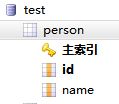2流高手速成记(之三):SpringBoot整合mybatis/mybatis-plus实现数据持久化
优质资源分享
| 学习路线指引(点击解锁) | 知识定位 | 人群定位 |
|---|---|---|
| Python实战微信订餐小程序 | 进阶级 | 本课程是python flask+微信小程序的完美结合,从项目搭建到腾讯云部署上线,打造一个全栈订餐系统。 |
| Python量化交易实战 | 入门级 | 手把手带你打造一个易扩展、更安全、效率更高的量化交易系统 |
接上回
上一篇我们简单介绍了基于SpringBoot实现简单的Web开发,本节来看Web开发中必不可少的内容——数据持久化
先看项目结构:
1. 创建数据表
打开mysql,打开数据库 test (没有可以创建一个),创建表格 person
给 person 表创建两个字段 id、name
2. 打开 pom.xml,添加相关依赖
org.mybatis.spring.bootgroupId>
mybatis-spring-boot-starterartifactId>
2.2.2version>
dependency>
com.baomidougroupId>
mybatis-plus-boot-starterartifactId>
3.5.2version>
dependency>
mysqlgroupId>
mysql-connector-javaartifactId>
dependency>
mybatis-spring-boot-starter 满足了 mybatis在springboot下的拆箱即用
mybatis-plus-boot-starter 实现了 mybatis-plus 的自动化配置,同样拆箱即用
注意:是mybatis-plus-boot-starter,不是mybatis-plus;前者包含后者的引用,如果只引用后者执行程序会报错!
由于mybatis-plus是基于mybatis的,所以两者引用缺一不可
mysql-connector-java 是基础的mysql驱动接口,这个也是不可或缺的
mybatis是安全、优秀的java持久层框架,基于xml可灵活定制sql语句
mybatis-plus在mybatis的基础上做了更进一步的简化,可免去xml编写
同时,mybatis-plus遵循非侵入式设计的原则,即完全兼容原mybatis的使用习惯,非常方便
3. 给application.properties添加数据库配置
# mysql相关设置
spring.datasource.username=admin
spring.datasource.password=admin
spring.datasource.url=jdbc:mysql://localhost:3306/test?useSSL=false&useUnicode=true&characterEncoding=utf-8&serverTimezone=GMT%2B8
spring.datasource.driver-class-name=com.mysql.cj.jdbc.Driver
到这里可能有人会问,咋没看到mybatis.xml的配置?不是一般都会有一句:
#指定Mybatis的Mapper文件
mybatis.mapper-locations=classpath:mapper/*xml
如果我们使用mybatis的原生功能,这一句配置是需要加上的,但是如果我们基于mybatis-plus,可以先不加这一句,因为它是免xml配置的!
4. 新建 model/Person
package com.example.hellospringboot.model;
public class Person {
private Integer id = 0;
private String name = "";
public Integer getId() {
return id;
}
public void setId(Integer id) {
this.id = id;
}
public String getName() {
return name;
}
public void setName(String name) {
this.name = name;
}
}
注意:类名 Person 要和数据库表名 person 一致(首字母大写是Java的类命名规则,这个没有问题)
id和name两个字段的名称和类型也要和数据库保持一致
5. 新建 mapper/PersonMapper
package com.example.hellospringboot.mapper;
import com.baomidou.mybatisplus.core.mapper.BaseMapper;
import com.example.hellospringboot.model.Person;
import org.apache.ibatis.annotations.Mapper;
import org.springframework.stereotype.Repository;
@Mapper
@Repository
public interface PersonMapper extends BaseMapper {
}
这里让PersonMapper继承自mybatis-plus提供的BaseMapper,这是启用mybatis-plus免xml特性的关键!
BaseMapper为我们定制常用的数据库增删改查的方法,直接继承使用即可!
6. 新建 service/PersonService 接口及其实现类 service/impl/PersonServiceImpl
package com.example.hellospringboot.service;
import com.example.hellospringboot.model.Person;
import java.util.List;
public interface PersonService {
Integer insert(Person person);
Integer update(Person person);
Integer delete(int id);
List select();
}
package com.example.hellospringboot.service.impl;
import com.example.hellospringboot.mapper.PersonMapper;
import com.example.hellospringboot.model.Person;
import com.example.hellospringboot.service.PersonService;
import org.springframework.beans.factory.annotation.Autowired;
import org.springframework.stereotype.Service;
import java.util.List;
@Service
public class PersonServiceImpl implements PersonService {
@Autowired
PersonMapper mapper;
public Integer insert(Person person){
return mapper.insert(person);
}
public Integer update(Person person){
return mapper.updateById(person);
}
public Integer delete(int id){
return mapper.deleteById(id);
}
public List select(){
return mapper.selectList(null);
}
}
我们给mapper新增了@Repository注解,可以让Service自动装载Mapper不报错
通过代码我们可以看到,继承自BaseMapper的PersonMapper,不加任何代码不写任何xml,就可以支持Person数据模型的常见的增删改查等操作,真的非常方便!
7. 新建 controller/PersonController
package com.example.hellospringboot.controller;
import com.example.hellospringboot.model.Person;
import com.example.hellospringboot.service.PersonService;
import org.springframework.beans.factory.annotation.Autowired;
import org.springframework.web.bind.annotation.GetMapping;
import org.springframework.web.bind.annotation.PostMapping;
import org.springframework.web.bind.annotation.RequestMapping;
import org.springframework.web.bind.annotation.RestController;
import java.util.List;
@RestController
@RequestMapping("/person")
public class PersonController {
@Autowired
PersonService service;
@PostMapping("/insert")
public Integer insert(Person person){
return service.insert(person);
}
@PostMapping("/update")
public Integer update(Person person){
return service.update(person);
}
@PostMapping("/delete")
public Integer delete(int id){
return service.delete(id);
}
@GetMapping("/select")
public List select(){
return service.select();
}
}
我们这里使用了@RestController注解,这样可以非常方便的测试我们的业务逻辑
这里可以看到,insert、update、delete三个写方法我们使用了Post协议,select读方法使用了Get协议
其实标准的RestApi风格另外还有Put和Delete协议,这里其实没有严格的规定
由于Get协议的参数是直接暴露在url串里的,所以一般写方法我们不建议使用Get协议
8. 使用Postman测试结果
我们在请求参数中分别传入id和name,springboot框架会自动将其拼装成Person对象,真的是非常智能化!
另外,得益于mybatis-plus免xml的特性,我们不用自己手写任何的xml逻辑实现,甚至通篇未出现任何大家常见的mybatis相关配置!
以上。
本节内容我们介绍了数据持久化的相关操作,并且是基础传统的关系型数据库——mysql
下一节我们将共同探讨如何使用SpringBoot整合redis及mongodb,敬请期待!








